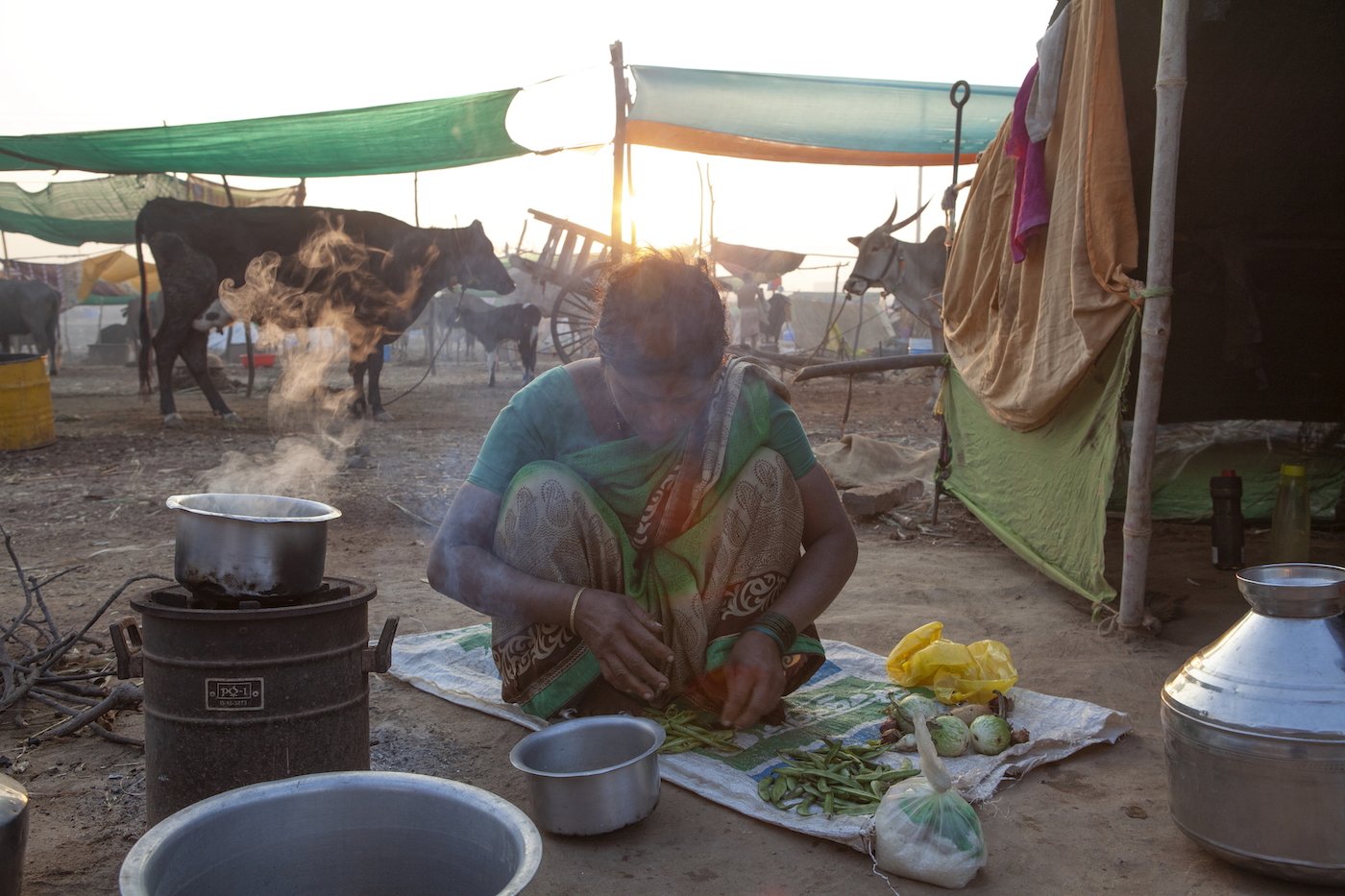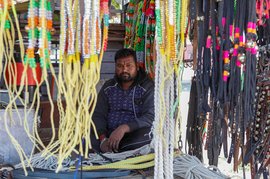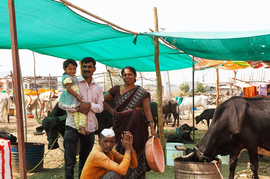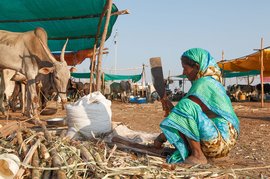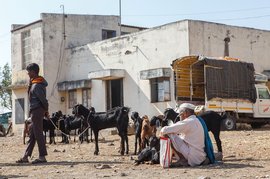It’s six in the evening. Time for the cows to come home. But in Masaiwadi, the cows will not be returning for six months. No cow bells, no mooing, no bustle of the milk collection vans and no smell of fresh cow dung. This village of around 315 households in Man block of Satara district in Maharashtra is silent. Half of its people and almost all the livestock have gone to a fodder camp, around five kilometres away, near Mhaswad town, which is over 100 kilometres from Satara.
Sangeeta Virkar, 40, too has shifted base there since January. She has brought along her two buffaloes and two Jersey cows, as well as a cow and a calf that belong to her old and infirm father. Her husband, Nandu, 44, has stayed back in the village to be with their 15-year-old daughter Komal, who is appearing for her Class 10 exams, and son Vishal, who is in Class 7. Their eldest daughter is married. The family’s three goats, a cat and a dog are at home too.
“The children at home and cattle in the camp. I have to look after both [the same way],” says Sangeeta, who is from the Dhangar community, a Nomadic Tribe. “We haven’t had a single spell of rain this year. We have 12 acres of land cultivated jointly by my husband and his two brothers. Normally, we get 20-25 quintals of jowar or bajra [in the kharif season]. But this year, we have got nothing. The entire crop was lost. No rain means no fodder. The rabi sowing is almost zero. How do we feed our animals?” she asks, patting a cow lovingly.
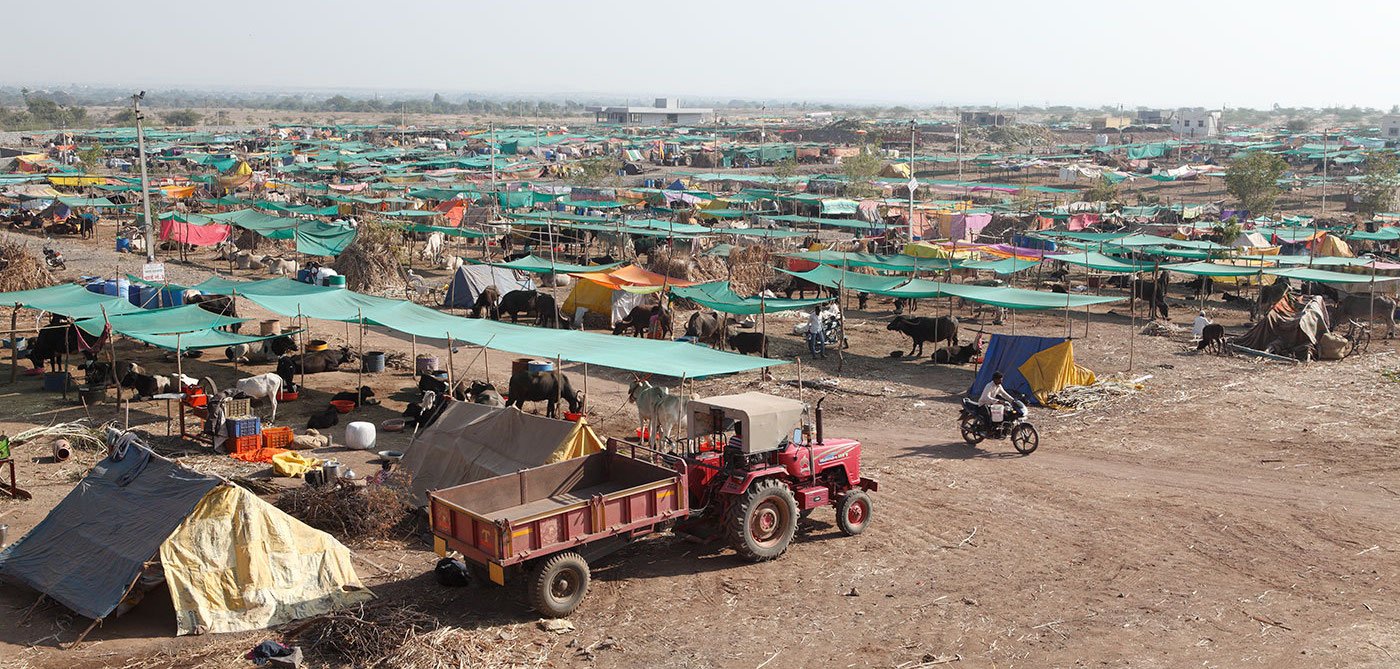
The cattle camp near Mhaswad town is sheltering nearly 8,000 cattle from 70 villages across the Maandesh region
Each of her Jersey cows were bought four years ago for Rs. 60,000. Each animal needs 20 kilos of fodder and 50-60 litres of water every day. But since November 2018, Masaiwadi has been subsisting on one water tanker once a week – just enough to provide 40 litres to each person. The water supplied by the Mhaswad Municipal Council to the village once in four days throughout the year has nearly stopped; the village well has dried up. There is no water to spare for the livestock. As the mercury rises from March, so will the need for water.
“There was absolutely no fodder and water in the village,” Nandu says. “So we sold the only bull we had. It costs 2,500 [rupees] to buy a bundle of 100 stalks that last for a month. Sugarcane costs 5,000 and lasts for around two months. The struggle to find water [for the animals] is another task. We are getting some sugarcane now, but after March we will not see any green fodder. We had got the bull for Rs. 30,000 in 2006. We raised him, took good care of him… and after 12 years, sold him for Rs. 25,000. I don’t think I will buy another one ever…” Nandu fights back his tears.
Man and Khatav talukas of Satara district are in a region known as Maandesh, as are Jat, Atpadi and Kavathemahankal talukas in Sangli, and Sangole and Malshiras in Solapur. It’s a rain shadow region, prone to extreme water scarcity and recurring drought. This increases the dependence of farmers and farm labourers on their livestock. And when an entire crop is lost to drought and water and fodder become scarce, entire villages are forced to migrate.
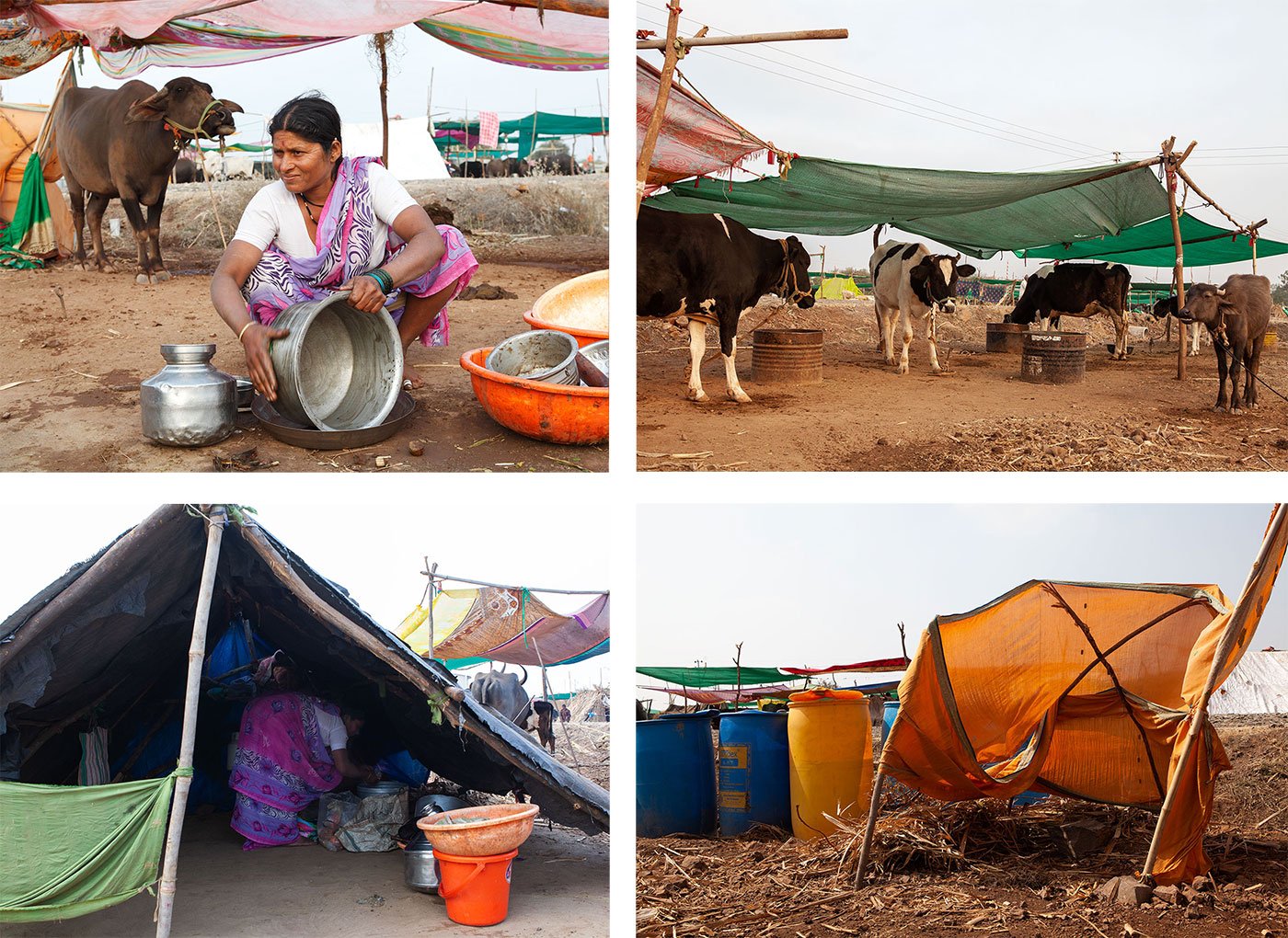
At the camp, in her flimsy tent next to a cattle shed, Sangeeta Virkar says, 'The list [of tasks] is endless'
Coping in cattle camps
On October 31, 2018, drought was declared in 151 blocks of 26 districts in Maharashtra, of which 112 blocks are facing a severe drought. Man-Dahiwadi from Satara is included in this list. All blocks comprising Maandesh are on the list. A report of the Department of Water and Sanitation titled Probable Water Scarcity 2018-19 says that by the end of October 2018, Man had received 193 mm of rain – or just 48 per cent of the average for the region. But these are averages – some villages have received as little as 3 mm of rain. The report also mentions that in 81 villages in the block, groundwater level has depleted by more than one metre and in 48 villages by more than 3 metres.
Around 1,600 people from 70 villages across Maandesh, along with 7,769 animals are staying at the cattle camp in Mhaswad. The camp was started on January 1, 2019, by the Mann Deshi Foundation, which is based in Mhaswad and supports the Mann Deshi Mahila Sahakari Bank by working on issues that go beyond financing. It’s the earliest cattle camp of this scale for villages facing the present drought. ( See 'Cattle and birds, both need a lot of water' )
When we reach there around 6:30 a.m., we see an ocean of sheds and cattle. Women are cleaning the sheds, milking cows, making tea. Some families have shifted here with their little kids, who are still asleep. Groups of men are sitting around campfires. Loudspeakers are playing devotional songs.
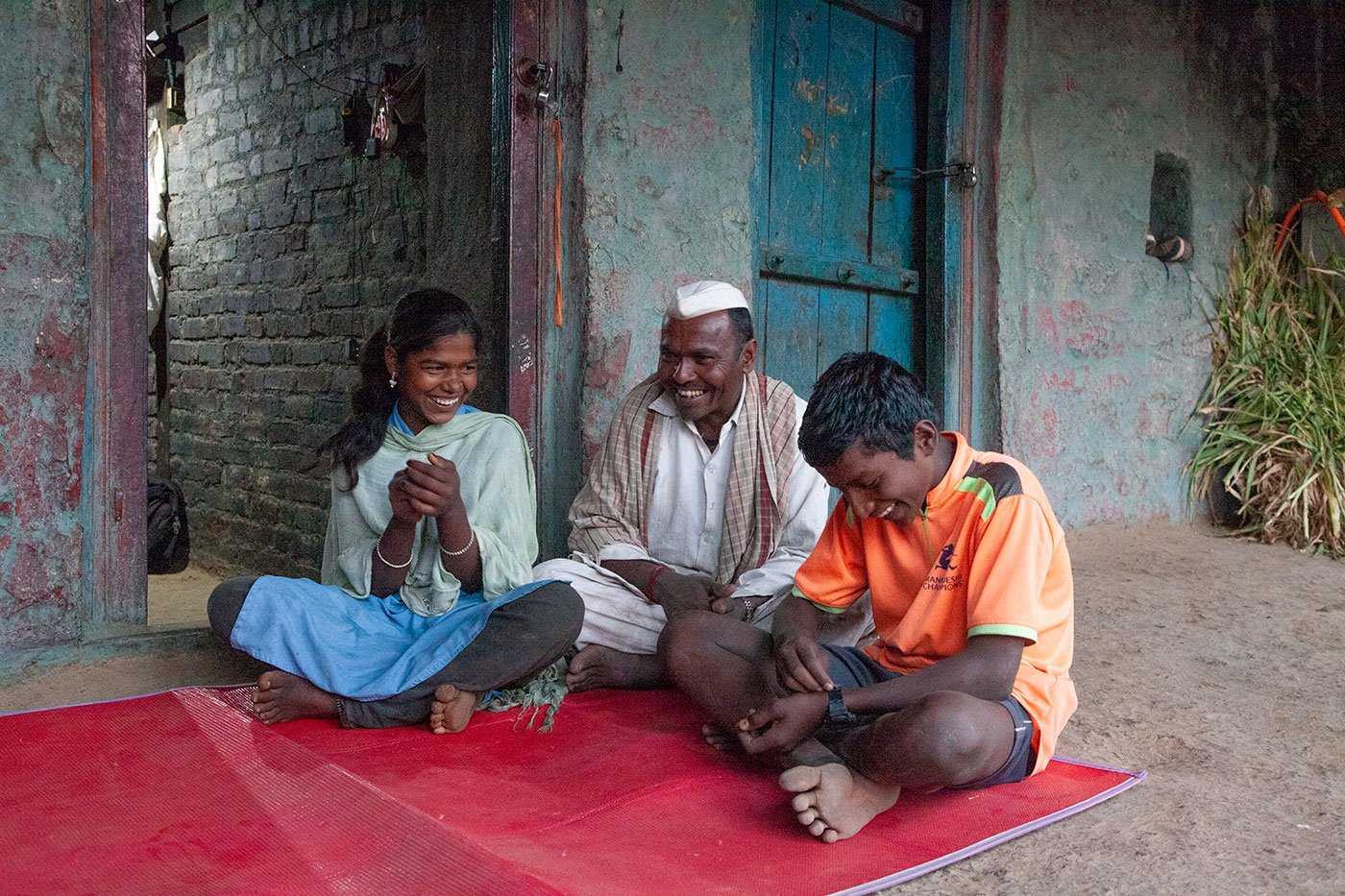
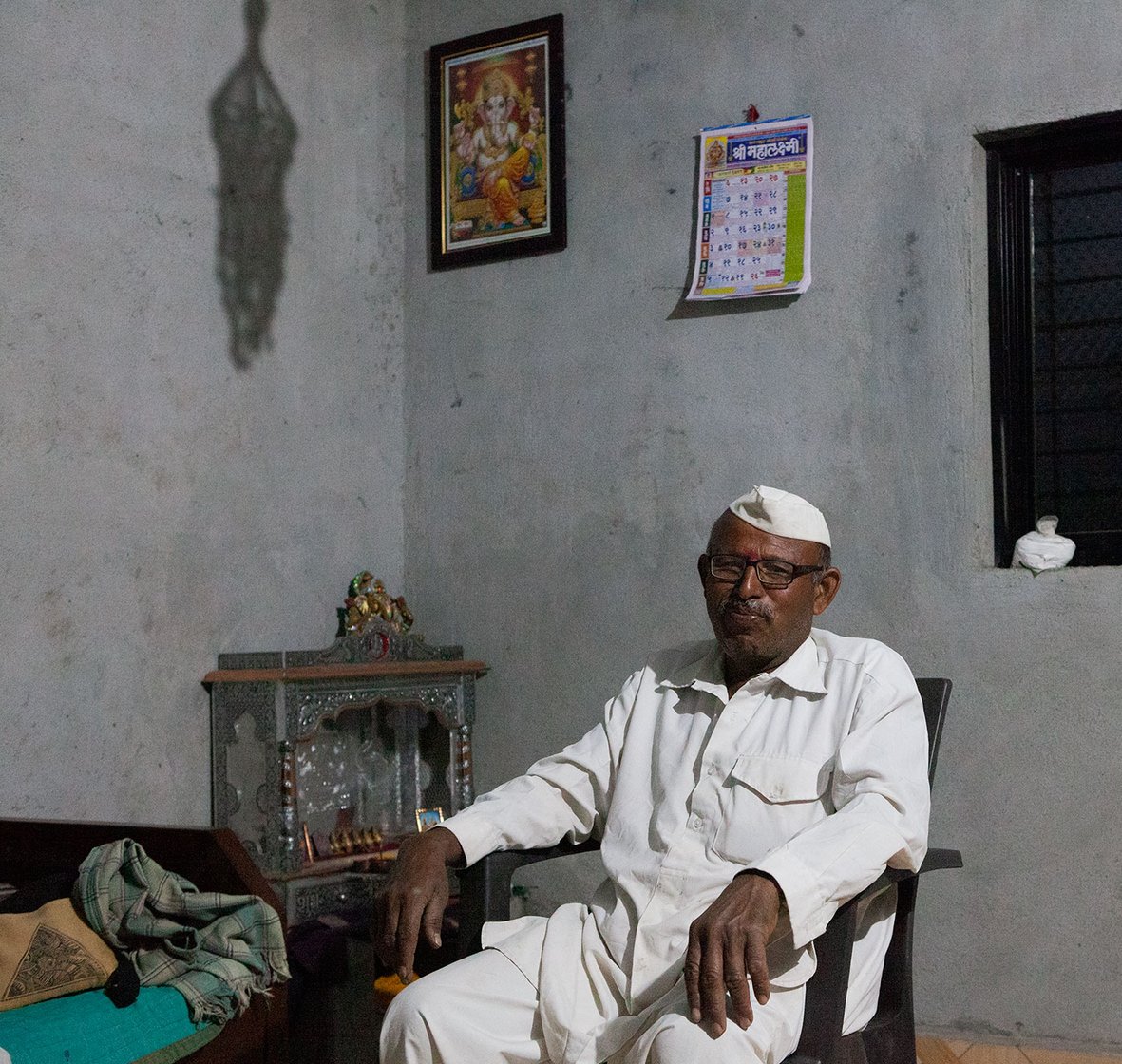
Left: Nandu, Sangeeta's husband, has stayed back in the village to be with their daughter Komal and son Vishal. Right: Naguanna too is at home in Masaiwadi to look after his father; his wife Vilasi is at the camp. 'It is ...almost as if we are divorced…' he says of these arrangements
“Here, our day starts before dawn,” says Sangeeta, who lost one eye to measles when she was in Class 2 and had to drop out of school. “We get up when it’s still dark, heat some water on the chulha and bathe [behind a torn saree tied to wooden poles]. Then we collect cow dung and sweep the shed, give water to the animals, feed them oilcakes and start milking. It is dawn by then. A tractor takes away the dung [for manure] and then we cook our morning meal. Then we wait for our turn to collect green fodder, go to the depot [in the camp], weigh the fodder [15 kilos each for bigger animals, 7 kilos for calves] and bring it here. I have to carry [at least] 70 kilos of sugarcane at one go. Then we have to cut it into smaller pieces. These animals need to drink water at least thrice. The list is endless,” she says, rinsing utensils while talking. (See Chimnabai gets to eat finally, with 8,000 others )
The camp organisers provide fodder, water and veterinary services for the livestock and basic amenities to the people. For example, water barrels are placed in each ‘ward’ in the camp (a tanker brings water every second or third day), and there is a tank for drinking water. The cattle sheds are built by the people using wooden poles and a green net on top provided by the Foundation. The women live next to the sheds, in flimsy huts made of tarpaulin or sarees.
Vilasi Virkar’s cattle shed is right next to Sangeeta’s; she too is from the Dhangar community. With Vilasi are her family’s two buffaloes, one Jersey cow, one Khillar cow and two calves. Vilasi was born in 1972, one of the worst drought years in Maharashtra. “Born in drought, so bear the drought for life,” she says, dejected. Her husband Nagu and elderly father-in-law have stayed back in Masaiwadi. There are goats to look after at home. Vilasi's daughter and elder son have college degrees and work in Mumbai, where her younger son too is studying for a BCom degree. So it was Vilasi who came with the livestock to the camp.
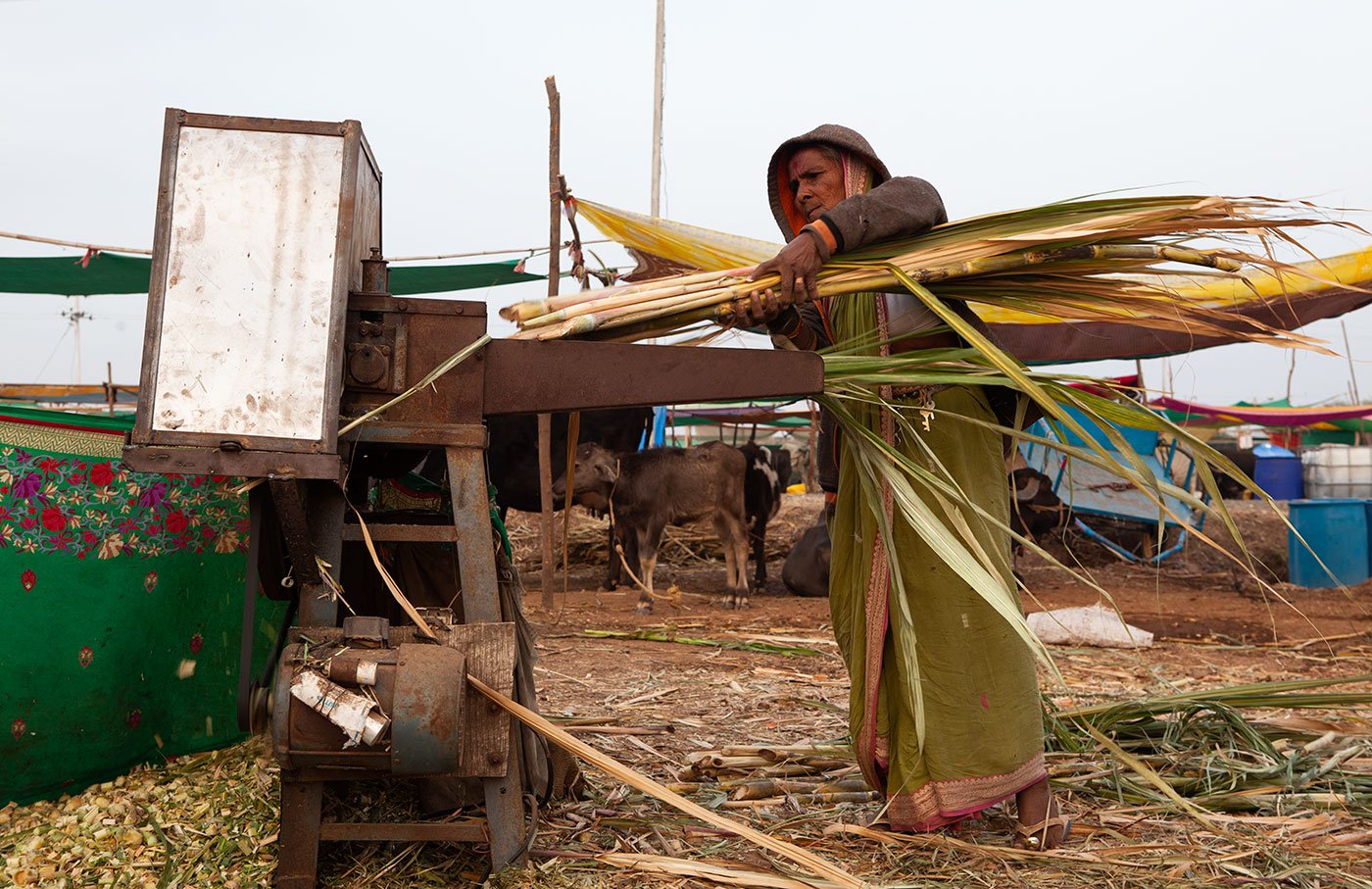
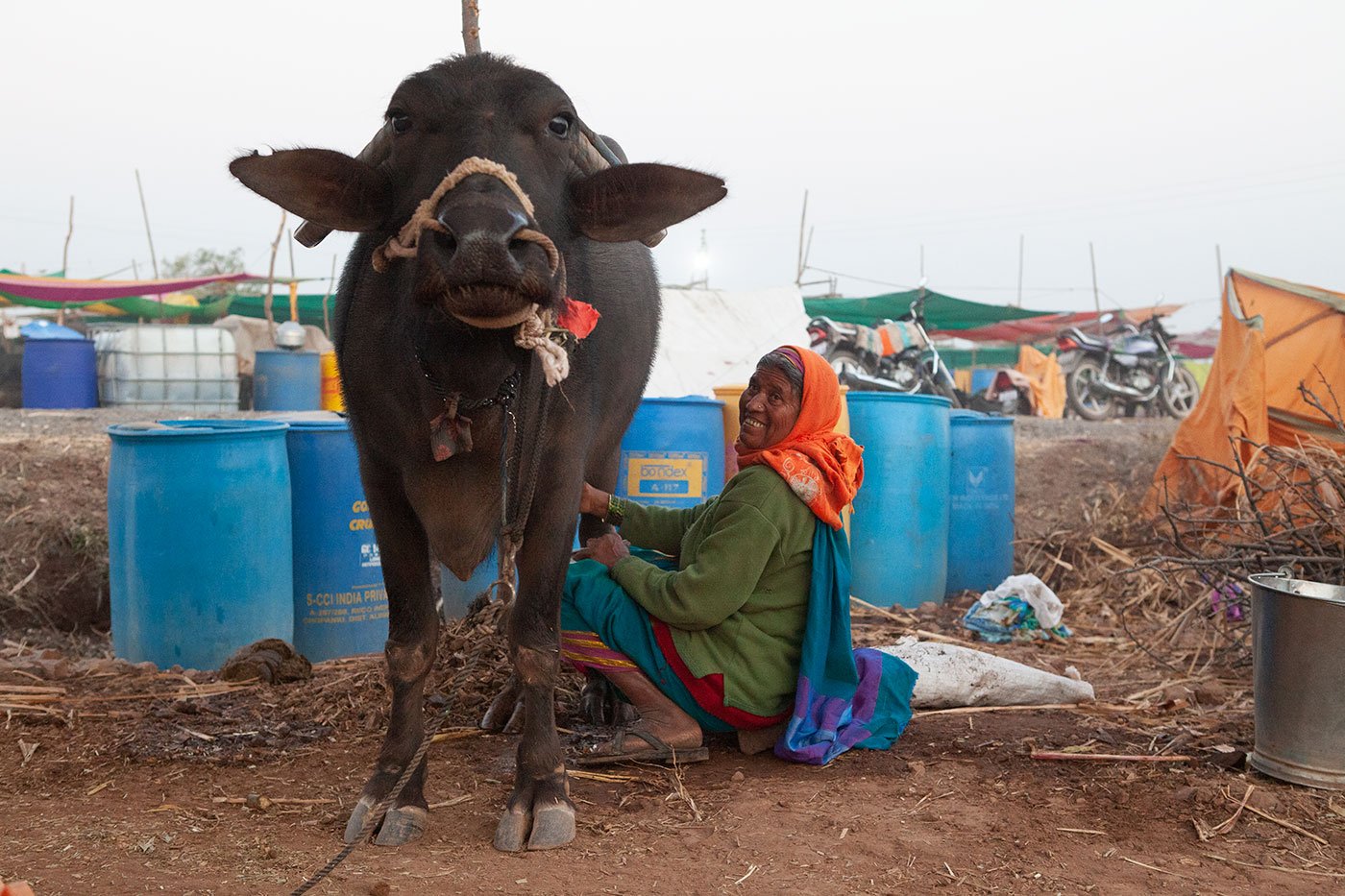
Left: Ranjanabai Virkar from Masaiwadi cutting cane leaves in a machine for her cattle. Right: Lilabai Virkar is hoping to keep her animals alive through the drought
She and the other women at the camp have carried chul has (just three stones in some instances, and sticks or sugarcane leaves as fuel) or gas stoves from home, as well as a few utensils. The groceries and provisions are brought to the camp by their family members every Wednesday from the weekly market in Mhaswad. Vilasi cooks for herself and for home – usually, brinjals, potatoes and lentils with bajri bhakri – packs the food and sends it with someone going back to the village. “There is no one at home to cook. So they eat out of the tiffin box. This is how it will be for the next 6-8 months,” she says.
Vilasi, Sangeeta and and many other women stay at the camp from Monday to Friday and visit their home on weekends. When they are back in their villages, their husbands, older children or relatives stay at the camp. People from the same hamlet or village have shifted together and support each other in this recurring back and forth between camp and village.
The women spend their weekends at home cleaning, sweeping, washing clothes, grinding grain, spreading dung on the floor – and doing various other tasks. Then they return to the camp. “At home, we would have to go to the fields or for labour. Here we don’t need to do that. That’s the only relief!” says Vilasi.
The mooing has stopped in Masaiwadi
“It is like living under two roofs, almost as if we are divorced…” says her husband, 52-year-old Naguanna, when we meet him in Masaiwadi. With Vilasi away at the camp, he has to manage some of the housework, store water when the tanker arrives, visit Mhaswad to buy groceries, and look after his father. “We did not have a single good spell of rain. Usually we have enough water till Phalgun [the last month of the lunar calendar, usually, March]. But this time there was hardly any water available right from Diwali. It only drizzled once…”
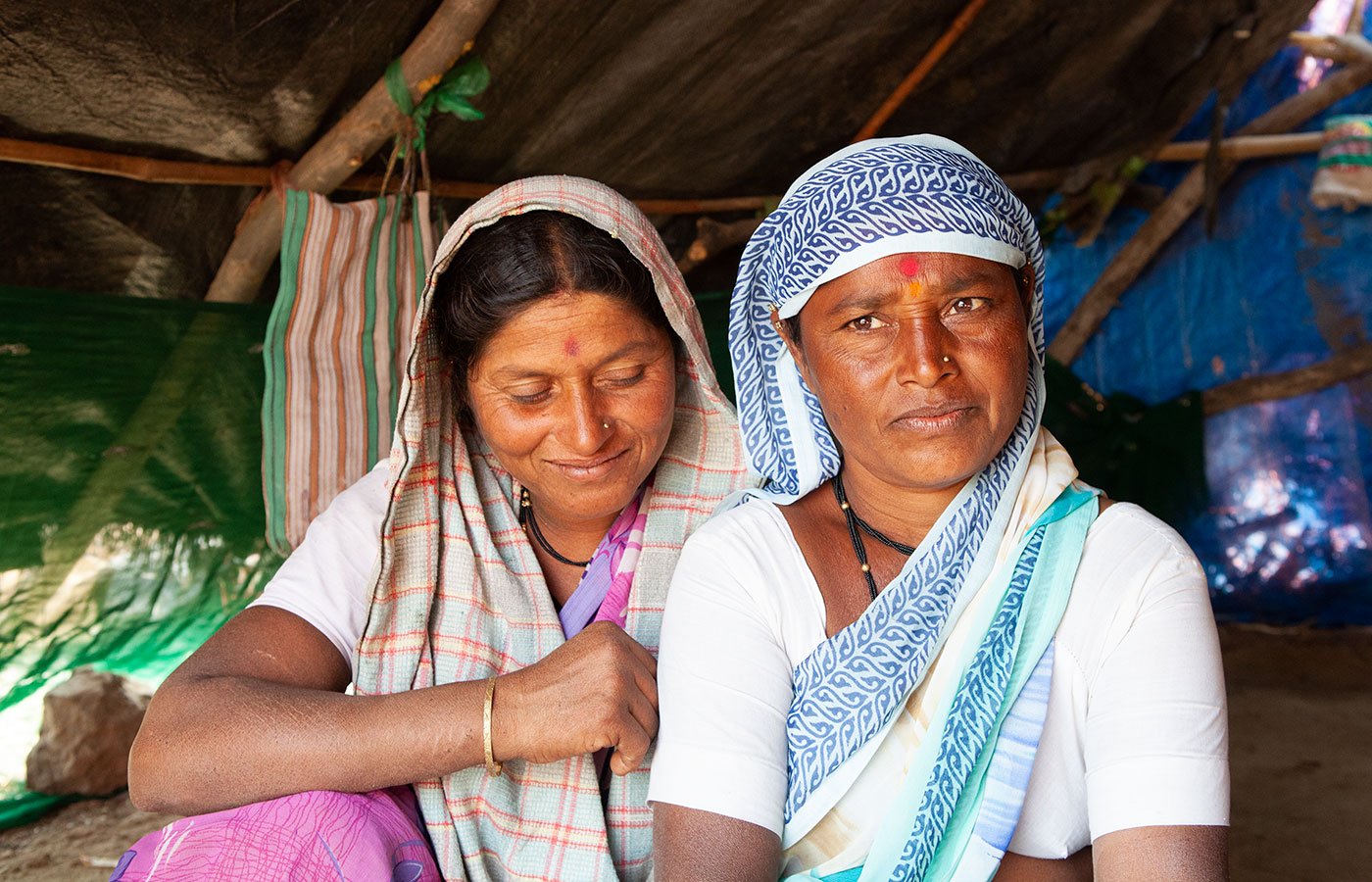
Sangita Virkar as well as Vilasi Virkar's families own land 10-12 acres of land. But, they say, 'We didn’t get any crop, so there is no grain'
“We didn’t get any crop, so there is no grain,” Vilasi adds. The family owns 10-12 acres, cultivated jointly by two brothers. “There is no daily wage work in the fields [women are paid Rs. 150, men get Rs. 250]. The government is not starting any work. Tell us, how do we survive?”
At Sangeeta’s home nearby, her husband Nandu says, “I am working at a brick kiln for a daily wage of Rs. 250 – but this work is for not more than a week. After that, I have no idea where I will find work. There is absolutely no work in the fields. We have lost our crop. Even after many visits to the bank, I have not received any crop insurance. We get some money by selling milk at Rs. 20 a litre. If we feed the cattle well, we get 4-5 litres daily. But we don’t have any milch animal at present. My father-in-law has sent his cow, so we are getting some 2-3 litres now.”
The family, he adds, had some grain stored from two years ago. “It is over now. When a farmer wants to sell jowar , he gets 1,200 [rupees] a quintal and when we have to buy it in the market we have to shell out 2,500 a quintal. Tell me, how we can manage? We have the orange [APL or ‘above poverty line’] ration card, so apart from three litres of kerosene, we get nothing, no grain, no sugar.”
In Masaiwadi and other villages, MGNREGA sites are yet to start, as are state-supported fodder camps run by NGOs or other groups and individuals. A government resolution (GR) of January 9, 2019, has sanctioned funds to five
gau shalas
in Aurangabad, Beed, Jalna, Osmanabad and Parbhani (in the drought-prone Marathwada region) to start cattle camps; each of these can house 500 to a maximum of 3,000 animals.


Left: Sangeeta handles numerous tasks at the camp and at home (with her is Lilabai Virkar). Right: Trucks and tempos carry away the dung and milk from the camp
Sangli, Satara and Solapur districts do not feature in this GR. But another GR of January 25 mentions that fodder camps can be organised in all 151 drought-hit blocks and 268 revenue circles facing a drought-like situation. A subsidy of Rs. 70 for an adult animal and Rs. 35 for a calf will be provided and 15 kilos of green fodder or 6 kilos of dry fodder will be provided every third day. But only five animals per family can be enrolled in the camp. There are no guidelines on what’s to be done with the other animals. And not a single camp has been started so far, only proposals are still being considered, says Lalit Babar of the Dr. Ambedkar Sheti Vikas Va Sanshodhan Sanstha, Sangola.
“I don’t know when the government will start fodder camps,” says Sachin Menkudale of the Maan Deshi Foundation. The Foundation’s camp will operate for the next 6-8 months, says Ravindra Virkar, one of its main co-ordinators.
During these months, 60-year-old Lilabai Virkar, a widow from Masaiwadi, is hoping to keep her animals alive. “As the drought sets in, cattle traders start doing the rounds, waiting for us to sell the animals,” she says. “Those worth 60-70,000 are sold at a meagre 5-6,000. We never sell our cattle to a butcher. But if the government fails to open fodder camps, half of the cattle will end up in slaughter houses.”
